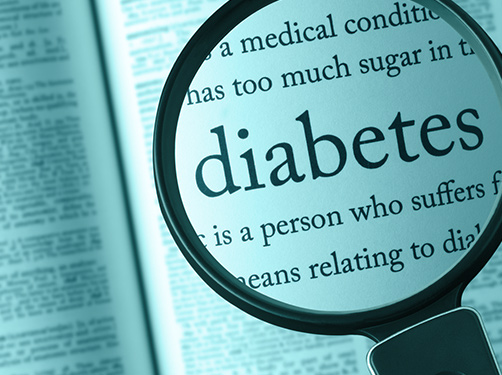Type 2 diabetes: Nutrition
Scientific support: PD Dr. Sabrina Schlesinger
A change in diet, together with physical activity, is the basis for the treatment of type 2 diabetes. This basic treatment is often sufficient in the early stages of the disease, meaning those with type 2 diabetes do not need any medication. This is especially true for overweight people with type 2 diabetes: They benefit especially from a more balanced diet and more physical activity through the accompanying weight loss and increased fitness levels.
Various diets, such as a Mediterranean-style, vegetarian or plant-based diet, are suitable for people with type 2 diabetes. In consultation with the doctor treating them or a qualified nutritionist, people with type 2 diabetes should choose the approach that can be easily integrated into their daily routine and that they can best adhere to.
The fun and enjoyment of eating should not be lost so that the change in diet can be implemented in the long term. Short-term crash diets are generally unsuccessful and lead to the yo-yo effect, which is accompanied by renewed weight gain.

Contents
- Why is nutrition so important?
- How do I eat correctly with type 2 diabetes?
- Do I need to pay particular attention to carbohydrates and sugar?
- What is the glycemic index?
- Should I lose weight?
- Can type 2 diabetes be reversed by changing my diet?
- What about sugar substitutes?
- What about alcohol?
- Who can help me with my dietary adjustment?
1. Why is nutrition so important?
A balanced diet provides the body with essential energy and nutrients. It also increases well-being and quality of life. Vitamins and minerals help us to feel fit and ensure that many processes in the body function properly. For example, secondary plant substances from fruit and vegetables help support the immune system. Among other things, fiber helps improve digestion, and long-term satiety, slows down the absorption of sugar from the blood and supports the intestinal flora. Some types of fat, so-called unsaturated fatty acids, such as being present in oily sea fish, nuts or linseed, support the functioning of thought-related processes.
According to a study conducted in 2023, around 70 out of 100 cases of type 2 diabetes are caused by an unhealthy diet. The development of type 2 diabetes was particularly associated with an inadequate intake of wholewheat products and an excessive consumption of processed cereal products such as white rice, white bread or white pasta, as well as processed and unprocessed red meat. A review study came to similar conclusions: A correlation was found between the consumption of red and processed meat, bacon and sugar-sweetened beverages and an increased incidence of type 2 diabetes. In contrast, the consumption of wholewheat products and fiber was associated with a lower incidence of type 2 diabetes. The evidence (significance) for these correlations is considered to be robust.
Diet, together with regular physical activity, is the basis of the treatment of type 2 diabetes and makes managing the disease easier. Especially at the beginning, people with type 2 diabetes can greatly influence their blood sugar levels by changing their lifestyle. A change in diet and increased physical activity are often sufficient for treatment without the need for antidiabetic drugs.
By eating a balanced and varied diet, people with type 2 diabetes can help reduce the risk of other accompanying diseases and complications. These include, for example:
A healthy and balanced diet also has a positive effect on elevated blood lipid levels and high blood pressure, which often accompany type 2 diabetes.
Find out more about possible complications of type 2 diabetes here.
2. How do I eat correctly with type 2 diabetes?
The diet for type 2 diabetes should always be balanced and varied and preferably includes nutrient-rich, low-processed foods with high levels of fiber. In contrast, high-energy foods with added sugars and saturated fats as well as white flour products such as white bread, white rice and white pasta should be avoided as far as possible.
Based on current knowledge, no definitive form of nutrition can be recommended for people with diabetes. Instead, various forms of nutrition have a positive effect on sugar metabolism, blood lipids and the risk of complications. For example,
- a plant-based (vegetarian and vegan) diet,
- the so-called Mediterranean-style diet,
- a low-carbohydrate diet and
- a protein-rich diet
represent possible options for people with type 2 diabetes.
So far, it has not been clearly established whether a certain type of diet is particularly suitable for people with type 2 diabetes in the long term. This is why personalized nutritional advice isrecommended for people with type 2 diabetes. Within this framework, a nutritional concept – adapted to the diabetes therapy as well as personal preferences and everyday circumstances – can be defined. What is important in this context is that the concept can be implemented individually in everyday life.
The German Diabetes Association (DDG) advises people with type 2 diabetes to focus on the commonalities of dietary patterns that have a positive effect on type 2 diabetes management. On the one hand, this means giving preference to vegetables with a high fiber and low starch content as well as less processed foods. In addition, added sugars and highly processed cereal products should be reduced or even avoided.
The composition of nutrients and the properties of food also play a decisive role in type 2 diabetes management. The following must be taken into account:
- The composition of the fat content (as much unsaturated fatty acids as possible, for example from rapeseed oil, oily sea fish, nuts and linseed and little saturated fatty acids, for example from sausage products)
- The content of fiber
- The effect of carbohydrate-containing foods on blood sugar levels
Good to know:
Special foods for people with diabetes are not necessary. They often contain certain sugar substitutes such as fructose. These substances have the same energy content as ordinary sugar and therefore offer no benefits. In addition, these products can contain a lot of fat and therefore more energy than normal foods. This can lead to weight gain and the development of a fatty liver. For this reason, it has no longer been permitted to sell special foods for people with diabetes in Germany since 2012.
Subtypes of type 2 diabetes
Researchers have proposed a new classification into a total of five diabetes subtypes. The subtypes are intended to make it possible to map and treat the complexity and individual progression of diabetes mellitus more accurately. The subtypes differ in terms of:
- The origin of the disease
- The course of the disease
- The risk of diabetes-related complications
To date, the data available on the nutrition in relation to diabetes subtypes is very limited. It is therefore not yet possible to derive specific dietary recommendations for the individual subtypes. This underlines the importance of individualized nutritional therapy in order to exploit the full potential of the basic therapy.
Oat Days:
If people with type 2 diabetes have severe insulin resistance, so-called oat days or fiber days can help to reduce insulin resistance. During oat days, only meals containing oats with a high fiber content are consumed over a period of 2 to 3 days. The energy intake during oat days is lower than the energy consumption.
Due to the composition of the oats and the high content of fibers, especially ß-glucan, the increase in blood sugar is lower than that in other meals that contain a comparable amount of carbohydrates.
Oat days are very effective, but should only be carried out under medical supervision. In particular people on insulin therapy run an increased risk of low blood sugar levels because insulin becomes more effective.
3. Do I need to pay particular attention to carbohydrates and sugar?
Carbohydrates, alongside fat and protein, are crucial energy sources for the human body. All carbohydrates are made up of sugar building blocks: some contain only 1 or 2 sugar building blocks (e.g., glucose or household sugar), whereas others are made up of long chains of sugar building blocks (for example starch). The body transforms the consumed carbohydrates into glucose (1 sugar building block) to generate energy.
A low-carb diet can contribute to an improvement in sugar metabolism and weight loss. Depending on the definition, a moderate low-carb diet is characterized by a content of 26 to 45 percent carbohydrates in total energy intake. A diet with fewer carbohydrates can be implemented through various dietary patterns, for example a Mediterranean-style diet.
People with type 2 diabetes should preferably take in carbohydrates from
- wholewheat products with a high content of whole grains;
- vegetables with a low starch content, such as leafy vegetables, cabbage, peppers, zucchinis, tomatoes, cucumbers and asparagus;
- legumes such as beans, peas, lentils, soy and soybeans; and
- low-sugar fruit, for example apples, pears, berries, citrus fruits and melon.
Among other things, these foods contain a lot of fiber which means that blood sugar rises more slowly. A daily intake of at least 30 grams of fiber is recommended. This corresponds, for example, to 5 portions of vegetables and fruit, at least 1 portion of pulses per week and 2 to 3 slices of wholewheat bread.
Good to know:
Not all whole grains are the same. In terms of blood sugar effectiveness, it is particularly important to pay attention not only to the degree of milling, but especially to the content of whole grains in wholewheat products. The more whole grains are contained in wholewheat products, the slower and lower the rise in blood sugar levels after consumption.
On the other hand, people with diabetes should eat the following foods in small quantities or avoid them:
- White flour products such as white bread/rolls, white pasta and white rice
- Products with free sugars, for example sweets, pastries, desserts, sweetened drinks
- Fast food and convenience products with a high content of saturated fatty acids such as frozen pizza, canned ready meals, French fries and potato chips
- Processed sausage products
These foods cause blood sugar levels to rise quickly. Specialist associations recommend no more than 50 grams of free sugars per day (less than 10 percent of total energy intake). This corresponds to about 12 teaspoons per day. Free sugar refers to all sugars added to foods and drinks and sugar naturally contained in honey, syrup, fruit juices, and fruit juice concentrates. Sugar-sweetened drinks should be avoided as far as possible and replaced with water or unsweetened tea.
Note: Processed foods often contain a lot of sugar, even though they taste salty.
People with type 2 diabetes should also consume starchy vegetables such as potatoes and corn as well as fruit (fruit products) in moderation. Pay attention to portion sizes and preparation.
If insulin therapy is required for people with type 2 diabetes, the amount of carbohydrate must be coordinated with the amount of insulin.
4. What is the glycemic index?
The glycemic index (GI) illustrates the effect of foods containing carbohydrates on the blood sugar level. It predicts how fast and how much the blood sugar will increase after eating a certain type of food.
The 100% reference value is the blood sugar level after the intake of 50 grams of dextrose. When comparing to other foods, the exact amount of the respective food that also contains 50 grams of carbohydrates is used. For example, that would be 100 grams of lentils or 60 grams of cornflakes. Foods containing carbohydrates that have a high GI (e.g., white bread, cornflakes, or French fries) cause a large and rapid increase in blood sugar levels. In contrast, foods containing carbohydrates that have a low GI (e.g., pulses, vegetables, and wholewheat products) enter the bloodstream more slowly, resulting in a more moderate increase in blood sugar levels.
Good to know:
Food can be divided into 3 groups based on the glycemic index(GI):
- A GI of 70 or higher is considered high.
- Foods with a GI of 56 to 69 have a medium GI.
- A GI of 55 or less is classified as low.
To estimate the effects of a food containing carbohydrates on the blood sugar level in relation to the amount of carbohydrates consumed, the glycemic load (GL) is also often calculated. GL provides an indication of the blood sugar response to a portion of a food containing carbohydrates. The GL is the product of the GI and the net carbohydrates (in grams) per food portion divided by 100.
Good to know:
Formula to calculate the glycemic load (GL):
GL = GI x consumed net carbohydrates [g] / 100
For example, a baguette and carrots have a similar GI. With a higher proportion of fiber and the corresponding lower proportion of net carbohydrates, the GL of carrots is significantly lower in comparison to the GL of a baguette.
Foods with lots of complex carbohydrates and fiber generally have a lower GI. The method of preparation also has an effect on the GI. Cooked carrots, for example, have a higher GI than raw carrots, as cooking breaks down the cell structure and the carbohydrates are released more quickly. The side dishes of a meal also influence how quickly the carbohydrates enter the bloodstream.
People with type 2 diabetes should prefer high-carb foods with a low GI. A low GI or low GL (glycemic load) not only has a positive effect on blood sugar levels, but also on blood lipids. In addition, a low GI/GL is associated with a higher intake of fiber, micronutrients and phytochemicals and a lower consumption of highly processed foods.
GI and GL of carbohydrate-containing foods (average values):
Please note that the values can vary greatly, especially for bread, depending on the recipe.
Food | GI [in percent] | Amount of carbohydrate [gram/portion] | GL per portion |
Wheat bread (white bread) | |||
73 | 15 | 11 | |
Wholemeal wheat bread | 75 | 15 | 11 |
Mixed grain or oilseed bread | 56 | 15 | 8 |
Spelt wheat bread | 61 | 15 | 9 |
Rye bread | 60 | 15 | 9 |
Oat bread | 65 | 15 | 10 |
Cornflakes | 80 | 20 | 16 |
Jasmine rice (cooked) | 89 | 45 | 40 |
Basmati rice (cooked) | 60 | 45 | 27 |
White rice (cooked) | 73 | 45 | 33 |
Brown rice (cooked) | 65 | 45 | 29 |
Parboiled rice (cooked) | 64 | 45 | 29 |
Long grain rice (cooked) | 62 | 45 | 28 |
Quinoa (cooked) | 53 | 45 | 24 |
Spaghetti (white, cooked) | 47 | 40 | 19 |
Wholemeal spaghetti (cooked) | 50 | 40 | 20 |
Potato (cooked) | 73 | 20 | 15 |
Potato (cooked and cooled overnight) | 49 | 20 | 10 |
Mashed potatoes | 79 | 20 | 16 |
Mashed potatoes (instant) | 84 | 20 | 17 |
Sweet potato (in the oven) | 88 | 20 | 18 |
Sweet potato (cooked) | 46 | 20 | 9 |
Modified according to Atkinson, F. S. et al. (2021)
5. Should I lose weight?
Being overweight or obese promotes the the onset of type 2 diabetes. In many studies, scientists have shown that overweight people with type 2 diabetes were able to notably improve their blood sugar values by losing weight.
Furthermore, being overweight or obese – alongside type 2 diabetes – can cause a wide range of complications that severely impair quality of life. These include, for example fat metabolic disorders, high blood pressure, cardiovascular diseases, tumor, kidney and lung diseases as well as mental illness. Weight loss can prevent the onset of these complications and improve quality of life.
The appropriate weight loss should be determined individually as part of nutritional counseling. When losing weight – especially in older people with type 2 diabetes – care should be taken to minimize the loss of muscle mass.
After losing weight, it is important to maintain the weight in the long term. In addition to diet, regular physical activity (even of low intensity) and a lasting change in behavior play a decisive role. Both the strategy for weight loss and subsequent weight maintenance should be based on individual preferences and feasibility.
Replacing meals with so-called formula diets with a low calorie content can be used as an initial measure to achieve a reduced calorie intake and thus promote weight loss. However, it is crucial that these successes and further weight loss are maintained through a long-term change in diet. Various options are available for long-term weight loss and stabilization of body weight:
- A moderate low-carb diet in which the intake of simple carbohydrates such as sugar and refined carbohydrates is reduced.
- A plant-based diet in the form of a Mediterranean-style or vegetarian diet, in which the intake of animal products is reduced and plant-based foods such as wholewheat products, vegetables, fruit, pulses, nuts and healthy fats are consumed more often.
- Intermittent fasting can also help you lose weight if you have a negative energy balance. Due to the increased risk of low blood sugar levels, medical supervision is required.
- Both low-carb and low-fat diets are effective in maintaining weight in the long term. The choice between them should be made individually, based on personal preferences and health goals.
According to current knowledge, no diet is clearly superior in terms of weight loss. Whether a diet to achieve weight loss is successful in the long term often depends on compliance, personal preference and compatibility with one’s daily routine. It is therefore important to choose a diet that is sustainable for the individual and can be integrated into everyday life.
Find out more about overweight and obesity and the treatment options here!
Good to know:
Weight loss should always be carried out in close consultation with a nutritionist or diabetes specialist and monitored by a doctor. Especially for people with type 2 diabetes and insulin therapy, close therapy monitoring is necessary in order to be able to adjust the insulin dose if necessary and to prevent low blood sugar levels.
6. Can type 2 diabetes be reversed by changing my diet?
An unhealthy lifestyle favors the development of type 2 diabetes. By losing weight, changing their diet and undertaking regular physical activity, some people can completely re-normalize their blood sugar levels. In these cases, antidiabetic drugs are no longer necessary. This applies in particular to overweight or obese people who have not had type 2 diabetes for long. In this context, experts speak of a remission of type 2 diabetes. The current study situation indicates that in the case of existing obesity, a weight loss of 15 kilograms or 15 percent of the initial weight should be achieved in order to achieve diabetes remission.
However, it is currently unclear whether remission can be achieved permanently.
7. What about sugar substitutes?
There are alternatives to conventional sugar for sweetening food and drinks. These sugar substitutes or sweeteners can be divided into two groups: Sweeteners and sugar substitutes are also known as sugar alcohols. They are classified as additives. This means that before they are allowed to be used in the production of food, they must undergo an approval process. They must also be listed on the food in the list of ingredients.
Sweeteners
Sweeteners are produced artificially and have a very high sweetening power – they are usually 30 to 3,000 times sweeter than conventional sugar. Sweeteners include, for example, cyclamate, saccharin, acesulfame, aspartame, and stevia. They are often found in low-calorie foods such as sweets, desserts and soft drinks or in processed foods. They are also available as table sweeteners.
The most important properties of sweeteners are:
- They have no influence on blood sugar.
- They provide no or very few calories.
- They do not cause tooth decay.
As part of the approval process, the European Food Safety Authority (EFSA) defines an acceptable daily intake (ADI for short) for sweeteners. Care must be taken to ensure that these maximum quantities are not exceeded. All food manufacturers in the EU must adhere to these maximum levels when processing sweeteners in food. In addition, sweeteners may only be used in certain foods.
Sugar substitutes
Sugar substitutes are usually of natural origin. Examples of sugar substitutes are sorbitol, xylitol, isomalt, maltitol, or lactitol. Due to their similar taste and volume, they are used and processed in food in a way similar to sugar. They can be found in ice cream, jams and sugar-free chewing gum, for example.
The most important properties of sugar substitutes are:
- They have only a minor effect on blood sugar levels.
- They contain fewer calories than conventional sugar.
- They do not cause tooth decay.
- They can cause stomach pain or diarrhea.
No maximum levels are set for sugar substitutes, with the exception of polyglycitol syrup (E 964). If the content of sugar substitutes in a food exceeds 10 percent of the total product, the warning „May have a laxative effect if consumed in excess“ is mandatory on the packaging.
It is not necessary to inject insulin for sweeteners or sugar substitutes. However, food packaging declares sugar substitutes as carbohydrates. People who require insulin therapy should look closely to see if these are carbohydrates that affect blood sugar levels or not. If the product contains sugar substitutes, then these should be subtracted during the calculation of the insulin dosage.
Health effects
According to current knowledge, the consumption of sugar substitutes is generally considered safe provided that the respective maximum amounts are observed.
However, the health effects of sweeteners and sugar substitutes are always the subject of controversy. The focus is particularly on possible effects on body weight, intestinal flora and the occurrence of obesity, type 2 diabetes, cancer and/or cardiovascular diseases.
Overall, little is known about the exact mechanisms of action of sugar substitutes in the human body – especially in the long term and with regular consumption. In addition, there are not enough studies available to conclusively assess a possible health risk. There is still a great need for research in order to be able to make precise statements about the health effects of sugar substitutes.
8. What about alcohol?
Alcohol consumption is associated with an increased risk of a variety of diseases such as liver, nerve and cardiovascular diseases. According to the latest scientific findings, even small amounts of alcohol are harmful to health. This is why the Deutsche Hauptstelle für Suchtfragen e.V. (DHS, German Center for Addiction Issues) advises people to avoid alcohol completely or to reduce its consumption as much as possible. This applies to people with and without diabetes.
Find information and tips on how to give up alcohol here.
Heavy alcohol consumption can lead to poorer control of sugar metabolism in people with type 2 diabetes. This also increases the risk of diabetes-related complications. For people with type 2 diabetes who inject insulin or take certain antidiabetic drugs, the consumption of alcohol also increases the risk of severe low blood sugar levels – especially at night. Therefore, alcohol should only be consumed together with carbohydrate-containing meals.
People with type 2 diabetes should clarify possible risks and the use of alcohol with their diabetes team.
9. Who can help me with my dietary adjustment?
Taking smaller steps in the beginning is often easier than making a radical change. New steps can be gradually introduced until the desired objective is achieved. The objective of nutritional therapy for type 2 diabetes is an individually tailored and balanced diet that meets individual nutrient requirements and leads to improved sugar metabolism.
Any change to a diet should be coordinated with the treating physician, also in the context of potentially preexisting complications.
All people with diabetes should also take part in a training program. Nutritional counseling that clarifies individual questions and needs should be part of this training and medical care. The doctor treating you can help you find a suitable program.
Sources:
Atkinson, F. S. et al.: International tables of glycemic index and glycemic load values 2021: a systematic review. In: Am J Clin Nutr, 2021, 114: 1625-1632
Bundesinstitut für Risikobewertung: Süßungsmittel: Mehrheit der Studien bestätigt keine Gesundheitsbeeinträchtigung – allerdings ist die Studienlage unzureichend. 2023 (Letzter Abruf: 19.04.2024)
Bundeszentrum für Ernährung: Süßungsmittel. (Letzter Abruf: 19.04.2024)
Deutsche Adipositas-Gesellschaft et al.: Quantitative Empfehlung zur Zuckerzufuhr in Deutschland. Konsensuspapier. 2018. Bonn
Deutsche Diabetes Gesellschaft: Stellungnahme des Ausschuss Ernährung der DDG zum Consensus Report: Nutrition Therapy for Adults with Diabetes or Prediabetes. 2019 (Letzter Abruf: 19.04.2024)
Deutsche Hauptstelle für Suchtfragen e.V.: Empfehlungen zum Umgang mit Alkohol.2023 (Letzter Abruf: 19.04.2024)
Evert, A. B. et al.: Nutrition Therapy for Adults with Diabetes or Prediabetes: A Consensus Report. In: Diabetes Care, 2019, 42: 731-754
International Standards Organization: ISO 26642-2010. Food products – Determination of the glycaemic index (GI) and recommendation for food classification. Geneva. 2010
Landgraf, R. et al.: Therapie des Typ-2-Diabetes. In: Diabetol Stoffwechs, 2023, 18: S162-S217
Lingvay, I. et al.: Obesity management as a primary treatment goal for type 2 diabetes: time to reframe the conversation. In Lancet, 2022, 399: 394-405
Neuenschwander, M. et al.: Role of diet in type 2 diabetes incidence: umbrella review of meta-analyses of prospective observational studies. In: BMJ, 2019, 366: I2368
O´Hearn, M. et al.: Incident type 2 diabetes attributable to suboptimal diet in 184 countries. In: Nat Med, 2023, 29: 982-995
Skurk, T. et al.: Empfehlungen zur Ernährung von Personen mit Typ-2-Diabetes mellitus. In: Diabetol Stoffwechs, 2023, 18: S270-S304
Strohm, D.: Glykämischer Index und glykämische Last – ein für die Ernährungspraxis des Gesunden relevantes Konzept? In: Ernährungs Umschau, 2013, 60: M26-M38
Szczerba, E. et al.: Diet in the management of type 2 diabetes: umbrella review of systematic reviews with meta-analyses of randomised controlled trials. In: BMJ Med, 2023, 2: e000664
Verband der Diabetes-Beratungs- und Schulungsberufe in Deutschland e.V.: Diabetes und Ernährung. 2. Auflage. 2023
Verbraucherzentrale: Süßungsmittel: Was sind Süßstoffe und Zuckeraustauschstoffe? (Letzter Abruf: 19.04.2024)
As of: 19.04.2024





